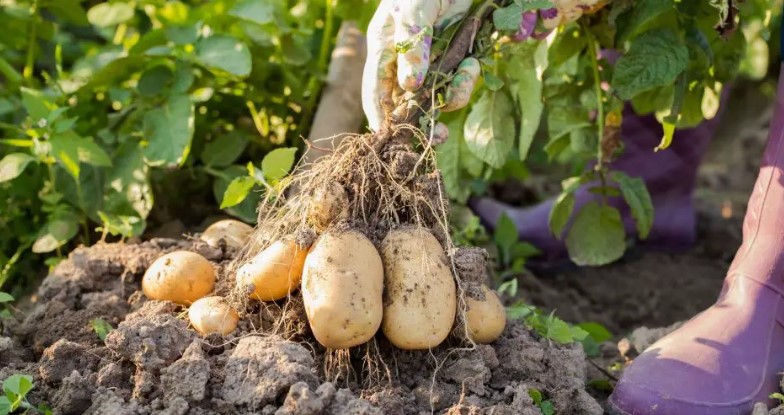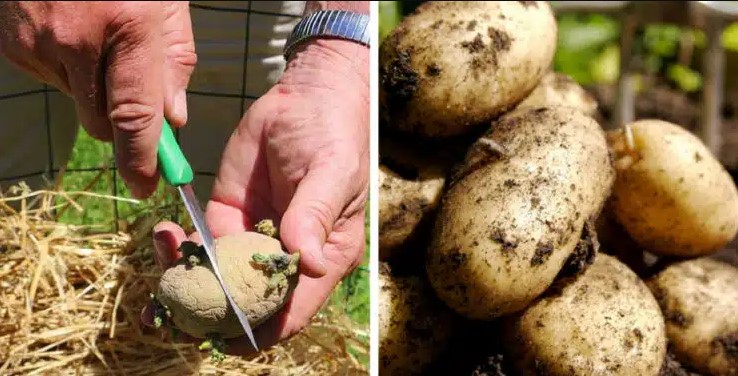Potatoes, versatile and hearty, are a staple in many households. What if you could have a continuous supply of these culinary wonders right at home?
Growing potatoes at home is not only satisfying but surprisingly simple.
In this article, we’ll explore the steps to cultivate potatoes in a way that provides a bountiful harvest and ensures a steady supply for your kitchen.

Selecting Potato Varieties
Before you start planting, choose the right potato varieties for your growing conditions. There are three main types of potatoes: russet, red, and fingerlings.
Each type has its own flavor, texture, and ideal use. Select varieties based on your culinary preferences and the space available for growing.
Materials You’ll Need
- Seed Potatoes: These are small potatoes specifically grown and sold for planting.
- Container or Garden Bed: Potatoes can be grown in the ground, in containers, or even in bags.
- Quality Soil: Well-draining soil with a mix of compost or well-rotted manure.
- Sunlight: Potatoes thrive in full sunlight, so choose a location that receives at least 6-8 hours of direct sunlight daily.
- Watering Can or Hose: Potatoes need consistent moisture, so a reliable watering method is crucial.
Steps to Grow Potatoes
1. Choosing Seed Potatoes
Purchase certified disease-free seed potatoes from a reputable source.
Cut larger seed potatoes into pieces, ensuring each piece has at least one or two eyes (the small indents from which sprouts emerge).
2. Preparing the Soil
Potatoes prefer well-draining soil with a slightly acidic to neutral pH.
Add compost or well-rotted manure to improve fertility. If you’re using a container, ensure it has drainage holes.
3. Planting
Plant your seed potatoes in early spring, about 2-4 weeks before the last expected frost. Space them 12-15 inches apart in rows, burying them 4-6 inches deep.
If you’re using a container, start with a few inches of soil, plant the seed potatoes, and cover them with more soil.
4. Hilling
As the potato plants grow, periodically mound soil around the stems to cover the emerging tubers.
This process, known as hilling, protects developing potatoes from sunlight, preventing them from turning green.
5. Watering
Keep the soil consistently moist but not waterlogged. Potatoes need about 1-2 inches of water per week, especially during dry spells. Water deeply to encourage root development.
6. Sunlight
Ensure your potato plants receive ample sunlight. Lack of sunlight can result in leggy plants and reduced tuber development. If growing in containers, position them where they can get the required sunlight.
7. Harvesting
Harvest your potatoes when the plants have flowered and the foliage begins to yellow and die back. Use a fork or your hands to gently unearth the potatoes. Be careful not to damage them during harvesting.
8. Storing
After harvesting, cure the potatoes by allowing them to dry in a cool, dark place for about two weeks. Store them in a cool, well-ventilated area, away from direct sunlight.
9. Continuous Harvest
To create an endless supply of potatoes, plant new batches every few weeks. This succession planting ensures a continuous harvest throughout the growing season.
Tips for Success
Rotate Crops
Avoid planting potatoes in the same location every year to reduce the risk of soil-borne diseases.
Use Mulch
Mulching around potato plants helps conserve moisture, suppress weeds, and maintain a more consistent soil temperature.
Watch for Pests and Diseases
Keep an eye out for common potato pests like Colorado potato beetles and practice good garden hygiene to prevent diseases.
Experiment with Varieties
Explore different potato varieties to enjoy a diverse range of flavors, textures, and colors.
Growing an endless supply of potatoes at home is a rewarding and surprisingly simple endeavor.
By choosing the right varieties, providing optimal growing conditions, and practicing succession planting, you can ensure a steady harvest of fresh, homegrown potatoes throughout the season.
With a little care and attention, your potato patch can become a constant source of culinary delight, offering the satisfaction of harvesting your own kitchen staples right from your backyard.










